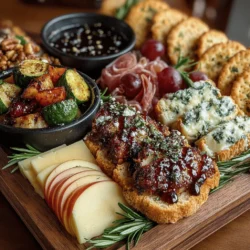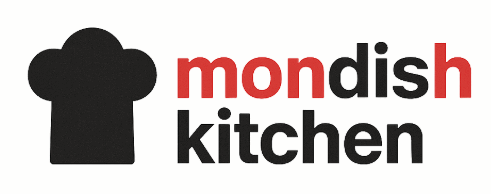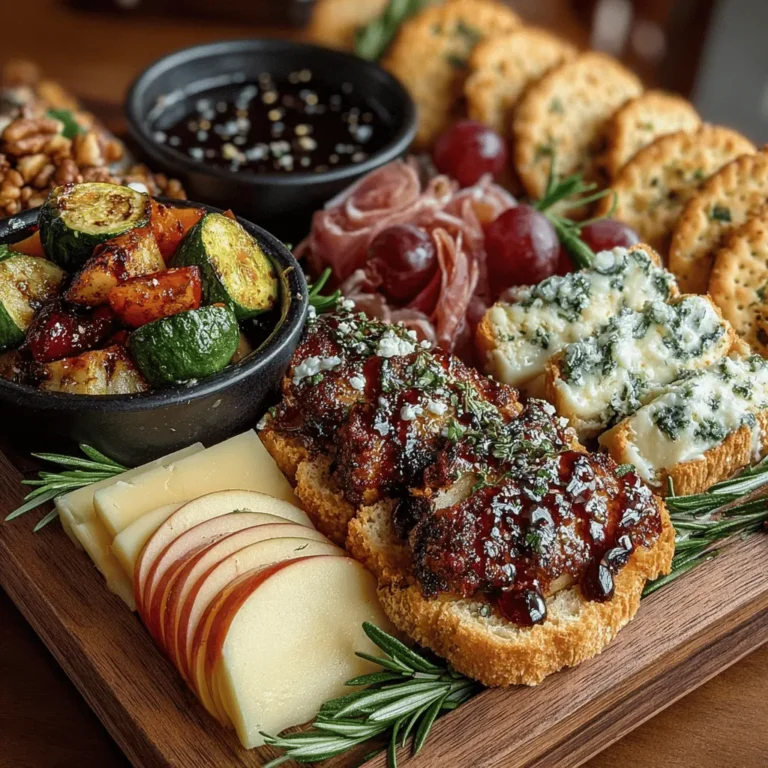Roasted Charcuterie Board Delight: A Flavorful Experience
In recent years, charcuterie boards have surged in popularity, becoming a staple at social gatherings, celebrations, and casual get-togethers. These artfully arranged spreads offer not just a meal but an experience, inviting guests to indulge in a variety of flavors and textures. The beauty of a well-crafted charcuterie board lies in its ability to showcase a diverse array of ingredients—from savory cured meats and creamy cheeses to crunchy vegetables and sweet accompaniments.
As we delve into the Roasted Charcuterie Board Delight recipe, it becomes clear why this dish is the perfect centerpiece for any occasion. Not only does it cater to a range of tastes, but it also encourages interactive dining, allowing guests to curate their bites as they mingle. This article will guide you through the enticing world of charcuterie boards, highlighting the essential components and providing insights into the selection of ingredients that will elevate your culinary presentation.
Understanding Charcuterie Boards
The term “charcuterie” originates from France, where it referred to the art of preparing and assembling cured meats and other meat products. Over time, the concept has evolved, embracing a wider array of ingredients beyond just meats. Today’s charcuterie boards are a colorful mosaic of flavors and textures that often include not only meats but also cheeses, vegetables, fruits, nuts, and various condiments.
The beauty of a charcuterie board lies in its diversity. Each component plays a distinct role, contributing to an overall experience that excites the palate. Cured meats serve as the savory foundation, while cheeses add creaminess and depth. Fresh vegetables provide crunch, fruits introduce sweetness, and accompaniments like olives and jams create complementary contrasts that enhance the flavors of the main ingredients. By carefully selecting and arranging these components, you can create a visually appealing and delicious spread that caters to a variety of tastes and dietary preferences.
Selecting the Perfect Ingredients
Creating a memorable charcuterie board begins with the selection of quality ingredients. The goal is to strike a balance between different flavors, textures, and colors, making the board not just delicious but also aesthetically pleasing. Here’s a breakdown of key ingredients to consider when assembling your Roasted Charcuterie Board Delight.
Cured Meats
1. Prosciutto: This Italian dry-cured ham is known for its delicate flavor and melt-in-your-mouth texture. Prosciutto pairs beautifully with sweet fruits like figs or pears, and its saltiness complements the creaminess of cheeses like Brie or goat cheese. When arranging your board, consider draping prosciutto slices elegantly to showcase their thin, translucent quality.
2. Salami: A staple in any charcuterie board, salami comes in various types, each with its own unique flavor profile. From the mildly spiced Genoa salami to the peppery Calabrese, the variety allows for creative pairings with cheeses and pickled vegetables. Depending on your preferences, you can choose to slice the salami thinly or serve it in thicker rounds for a heartier bite.
3. Chorizo: This Spanish sausage brings a spicy kick to your charcuterie board. With its rich, smoky flavor, chorizo pairs well with sharp cheeses like aged cheddar and can be complemented by the sweetness of roasted red peppers. Consider including both sweet and spicy varieties of chorizo to cater to different tastes.
Cheese Selections
The cheese component of your charcuterie board is just as important as the meats. A well-rounded selection of cheeses can enhance the overall experience and provide a delightful contrast to the savory elements.
1. Aged Cheddar: Known for its sharp, nutty flavor, aged cheddar is a crowd-pleaser that pairs well with an array of accompaniments, from apple slices to spicy mustard. Its crumbly texture and bold taste make it a perfect match for the richness of cured meats.
2. Brie: This soft, creamy cheese adds a luxurious element to your board. Its mild flavor and buttery texture make it a great pairing with sweet jams or honey, as well as with fruits like grapes or apples. Serve Brie at room temperature to enhance its creaminess and flavor.
3. Blue Cheese: For those who appreciate bold flavors, blue cheese is an excellent addition. Its distinctive tanginess can be balanced with sweet elements, such as honey or fig jam, and it pairs beautifully with nuts and dried fruits. Consider offering a milder blue cheese alongside a stronger variety to cater to different preferences.
Roasted Vegetables
Incorporating roasted vegetables into your charcuterie board not only adds visual appeal but also enhances the flavor profile. Seasonal vegetables like bell peppers, zucchini, and carrots can be roasted to bring out their natural sweetness and create a smoky depth that pairs well with meats and cheeses. When selecting vegetables, opt for colorful varieties to create an eye-catching display on your board.
Olives
Olives are a quintessential component of any charcuterie board, providing a briny contrast to the richness of meats and cheeses. When selecting olives, consider incorporating a mix of green and black varieties, as their distinct flavors can add complexity to your spread. Green olives, often firmer and more bitter, can be delightful paired with creamy cheeses, while black olives offer a milder and slightly sweet taste.
Sweet Elements
To balance the savory components of your charcuterie board, including sweet elements is essential. Honey and fig jam are popular choices, each offering distinct flavors that can enhance the overall experience. Honey drizzled over cheese or meats can create a delicious sweet-savory pairing, while fig jam adds a rich, fruity sweetness that complements sharp cheeses and cured meats beautifully. Fresh fruits like grapes, apples, or berries can also be included to provide a fresh burst of flavor and color.
Fresh Fruits
Fresh fruits are not just for decoration; they play a vital role in balancing the flavors on your charcuterie board. Their natural sweetness can counterbalance the saltiness of cured meats and the richness of cheeses. Grapes, figs, and sliced apples or pears are excellent choices that add color and freshness to your spread. Be sure to wash and prepare the fruits in a way that makes them easy for guests to enjoy alongside the other components.
As you prepare to assemble your Roasted Charcuterie Board Delight, keep in mind the importance of presentation. The arrangement of ingredients can transform your board into a stunning centerpiece that invites guests to explore and indulge.
In the following sections, we will delve into the step-by-step process of roasting vegetables and assembling your charcuterie board, ensuring that every bite is a delightful experience that will leave a lasting impression on your guests.
{{image_2}}
Creating a roasted charcuterie board is not just about assembling a variety of meats and cheeses; it’s an opportunity to showcase creativity and flavor. In this section, we will dive into the nitty-gritty of crafting the perfect Roasted Charcuterie Board Delight, highlighting essential components and providing tips for an unforgettable presentation.
The Importance of Nuts for Texture and Crunch
Nuts play a pivotal role in enhancing the texture of your charcuterie board. Their satisfying crunch contrasts beautifully with the creamy cheeses and tender meats, inviting your guests to indulge in every bite. Almonds, walnuts, and cashews are excellent choices because they bring not only flavor but also healthy fats and protein. Consider toasting your nuts lightly before serving to elevate their flavor profile. A sprinkle of sea salt or a dusting of spices can further enhance their allure, making them a delightful snack that complements the board’s other elements.
Selection of Bread and Crackers
How to Choose the Right Base for Your Charcuterie Board
The base of your charcuterie board, made up of breads and crackers, provides the perfect vehicle for enjoying the various toppings. A well-selected assortment will add texture and flavor diversity. Opt for a mix of crunchy and soft options to cater to different preferences.
– Crackers: Choose a variety that includes whole grain, herb-infused, and cheese-flavored crackers. Their shapes and sizes can vary, creating visual interest.
– Breads: Slices of baguette, ciabatta, or focaccia can add a rustic charm. Consider providing a gluten-free option for those with dietary restrictions.
Slicing the bread into different shapes—such as triangles, squares, or thin rounds—can create a dynamic visual effect, making your charcuterie board even more inviting.
Step-by-Step Guide to Assembling the Roasted Charcuterie Board
Prepping the Workspace and Materials Needed for Assembly
Before diving into the assembly process, ensure you have a clean, spacious workspace. Gather all your materials, including:
– A large wooden board or platter
– Small bowls for nuts, olives, and spreads
– Cheese knives and serving utensils
– Fresh herbs for garnish
– Parchment paper for easy cleanup
Detailed Instructions for Roasting Vegetables
Roasted vegetables add a wonderful depth of flavor to your charcuterie board. Here’s how to prepare them:
1. Choose your vegetables: Bell peppers, zucchini, carrots, and asparagus work beautifully.
2. Preheat your oven: Set it to 425°F (220°C) to ensure a hot environment for roasting.
3. Prep the vegetables: Wash and cut them into bite-sized pieces.
4. Toss with oil and seasonings: Drizzle with olive oil and sprinkle salt, pepper, and your choice of herbs—rosemary and thyme complement roasted vegetables perfectly.
5. Roast: Spread the vegetables on a baking sheet in a single layer. Roast for 20-25 minutes, flipping halfway to ensure even cooking.
Tips for Achieving the Perfect Caramelization
To achieve that beautifully browned exterior, avoid overcrowding the pan. This allows the vegetables to roast rather than steam. If necessary, roast in batches. Keep a close eye on them in the last few minutes to prevent burning, aiming for a golden-brown color that indicates they are perfectly caramelized.
Seasoning Recommendations for Enhanced Flavor
Experiment with different seasonings to customize your roasted vegetables. A sprinkle of smoked paprika, garlic powder, or even a drizzle of balsamic glaze can transform their flavor profile, making them an irresistible addition to your board.
Techniques for Arranging Meats and Cheeses
When it comes to meats and cheeses, presentation is key. Here are some techniques to arrange them beautifully:
– Fold and layer: For sliced meats like prosciutto or salami, fold them into quarters and layer them creatively.
– Cheese placement: Cut cheeses into various shapes—cubes, wedges, or slices—and place them in clusters. Consider using a mix of textures and flavors, such as sharp cheddar, creamy brie, and tangy goat cheese.
Visual Presentation Tips for an Inviting Display
Aim for balance in color and texture. Alternate light and dark items, and try to create a circular or spiral pattern with your meats and cheeses. Adding height can also make your board visually appealing; stack cheeses on top of each other or use small bowls to elevate certain items.
Incorporating Nuts and Fruits into the Layout
Nuts and fresh fruits can enhance both flavor and aesthetics. Here’s how to incorporate them effectively:
– Color Balance: Use colorful fruits like grapes, figs, or sliced apples to bring vibrancy to your board.
– Accessibility: Arrange nuts in small bowls or scatter them around the board to invite guests to grab a handful easily. This accessibility encourages mingling and enjoying the various flavors.
Adding Olives and Sweet Elements
Olives add a salty contrast to the board, while sweet elements like honey or fig jam provide a delightful balance. Place olives in a small bowl to prevent them from rolling around, and consider drizzling honey over cheeses or placing a small dish of jam near the crackers for easy access.
Best Practices for Placement and Presentation
When arranging your charcuterie board, think about flow and accessibility. Group similar items together but intersperse different textures and flavors to encourage exploration. Use small spoons for spreads and ensure that each item is easily reachable.
Preparing the Bread and Ensuring Variety
Slicing techniques can impact the presentation significantly. Here are some tips:
– Slicing Techniques: Cut breads into different shapes and sizes—thin slices for baguettes, cubes for focaccia, and wedges for pita.
– Serving Options: Consider placing a few slices of each type of bread on the board, preferably in a separate section, to maintain their freshness and prevent them from becoming soggy.
Final Touches with Roasted Vegetables and Garnish
As you finalize your charcuterie board, don’t overlook the importance of garnishing. Fresh herbs such as rosemary or parsley can add a pop of color and a fresh aroma, making your board even more inviting. Scatter some herbs in between the various elements to tie everything together visually.
Serving Suggestions and Presentation Tips
How to Present the Charcuterie Board at Gatherings
When presenting your charcuterie board, place it at the center of the table to encourage guests to gather around. Ensure it’s at a comfortable height for everyone to reach, and provide cocktail napkins nearby for easy access.
Suggestions for Cheese Knives and Serving Utensils
Make sure to provide appropriate utensils for your guests. A cheese knife for soft cheeses, a hard cheese knife for aged varieties, and forks for picking up meats and olives are essential. This consideration enhances the overall experience and facilitates ease of use.
The Importance of Interactive Elements for Guest Engagement
Encourage interaction by including elements like small labels next to each type of cheese and meat. This not only informs guests about what they’re sampling but also inspires conversation about flavor pairings and preferences.
Ideas for Pairing Beverages with the Charcuterie Board
Pairing beverages with your charcuterie board can elevate the entire experience. Consider offering:
– Wines: A crisp white wine pairs beautifully with lighter meats and cheeses, while a bold red complements richer flavors.
– Craft Beers: A selection of craft beers can cater to different taste preferences, enhancing the flavor profiles of certain meats.
– Non-Alcoholic Options: Sparkling water with a slice of lemon or a refreshing mocktail can keep things inclusive for all guests.
Conclusion
Assembling a Roasted Charcuterie Board Delight is not just a culinary task; it’s a joyful exploration of flavors, textures, and creativity. This versatile option shines at any gathering, from casual get-togethers to formal events. With the freedom to explore ingredient variations and personalize your board, you can create an experience that resonates with your guests.
Encourage your culinary creativity by experimenting with different combinations and presentations. Remember, the heart of a charcuterie board lies in the joy of sharing delicious food and engaging in delightful conversations. So gather your ingredients, invite friends over, and let the Roasted Charcuterie Board Delight become a centerpiece of your culinary adventures.


